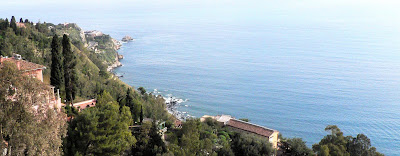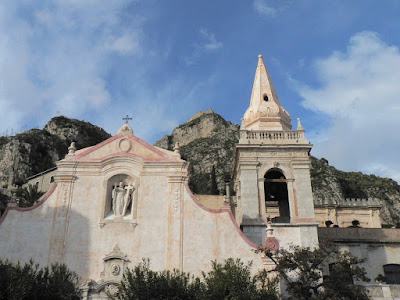
As children go to sleep tonight in Italy, they have the same anticipation that American children have on Christmas eve. Tonight Italian kids are expecting a visit from
La Befana. When they wake up in the morning there will be sweets and treats in their stockings and maybe a gift! (Or, there might be some coal!)
This is La Befana in our home.There is a legend that La Befana was approached by the Three Kings a few days before Christ's birth. They asked for directions to where the baby Jesus was, but she didn't know. She gave them shelter for the night. (She was considered the best housekeeper in the village with the most pleasant home.) The Three Kings invited her to join them on the journey to find the baby Jesus, but she said no because she was too busy with her housework. Later, La Befana had changed her mind, and tried to search out the Three Kings and Jesus. She was not able to find them. Even to this night, La Befana is searching for the baby Jesus. While she is searching, she leaves all the good children toys and candy, while the bad children get coal.

Stockings have been hanging in the Ambrit Rome International School atrium throughout the holiday season. When students return on January 7th they will discover that La Befana has left treats in their stockings.
 After New Years Day we found ourselves joining our friend Maria in Catania for a meal of horse and donkey meat. She took us to a street that boasted half-a-dozen macellerie equina e trattorie, "horse meat butchers and restaurants."
After New Years Day we found ourselves joining our friend Maria in Catania for a meal of horse and donkey meat. She took us to a street that boasted half-a-dozen macellerie equina e trattorie, "horse meat butchers and restaurants." On the street and sidewalks butchers displayed their meats while cooks prepared meals on outdoor grills. People young and old, most arriving on motorcycles, pulled up and ordered dinner.
On the street and sidewalks butchers displayed their meats while cooks prepared meals on outdoor grills. People young and old, most arriving on motorcycles, pulled up and ordered dinner. Some stood and ate on the street, others sat at tables on the sidewalk. We went inside to enjoy our meal.
Some stood and ate on the street, others sat at tables on the sidewalk. We went inside to enjoy our meal.
 From left to right:
From left to right:








































